Supply Chain Management and Lean Production
VerifiedAdded on 2020/11/23
|9
|3290
|454
Literature Review
AI Summary
This assignment delves into the concepts of supply chain management and lean production, examining their interconnectedness and influence on organizational agility. It encourages an analysis of how these principles are applied in both traditional business settings and within the context of humanitarian logistics. The assignment requires a thorough understanding of key theories, practices, and real-world applications in these areas.
Contribute Materials
Your contribution can guide someone’s learning journey. Share your
documents today.
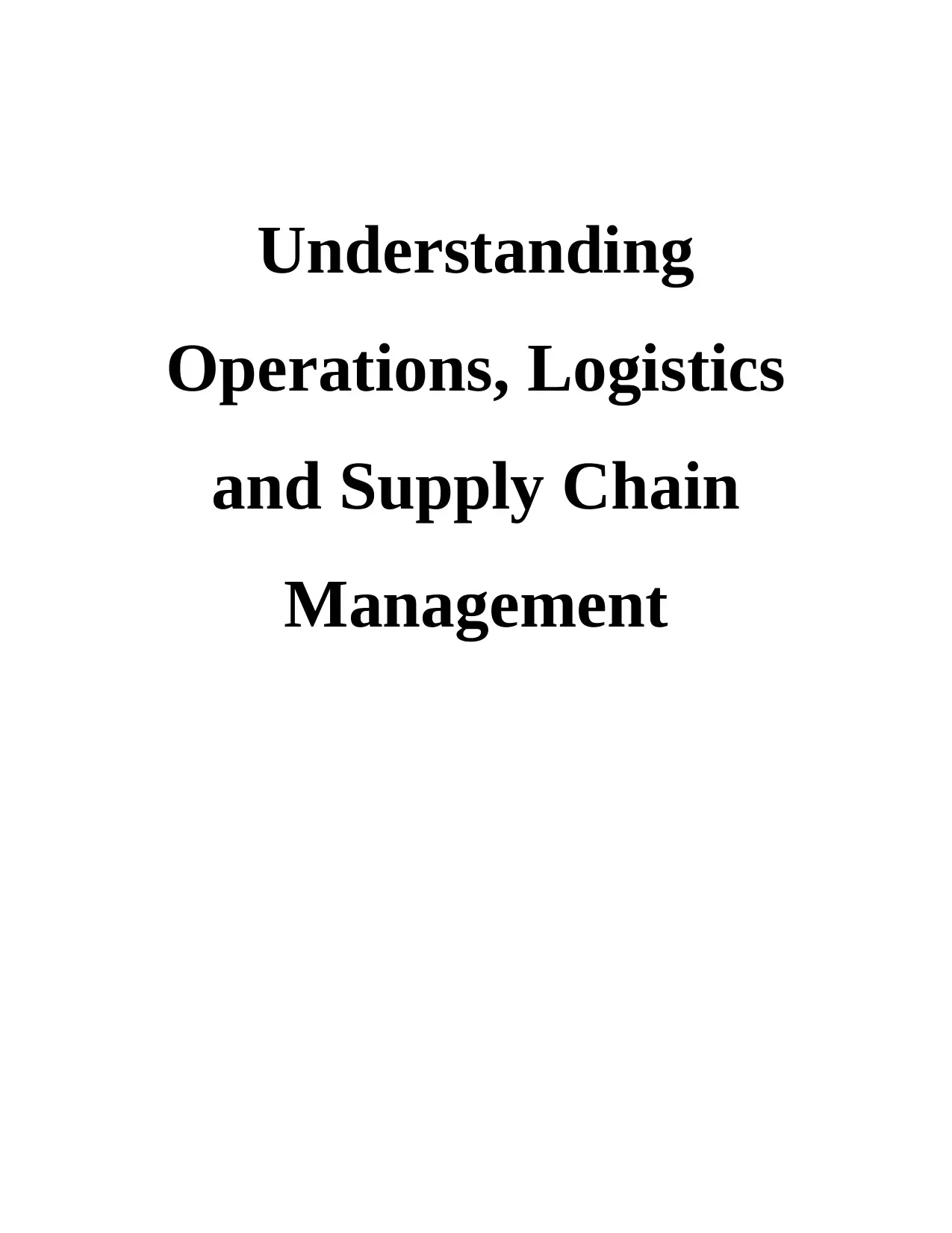
Understanding
Operations, Logistics
and Supply Chain
Management
Operations, Logistics
and Supply Chain
Management
Secure Best Marks with AI Grader
Need help grading? Try our AI Grader for instant feedback on your assignments.
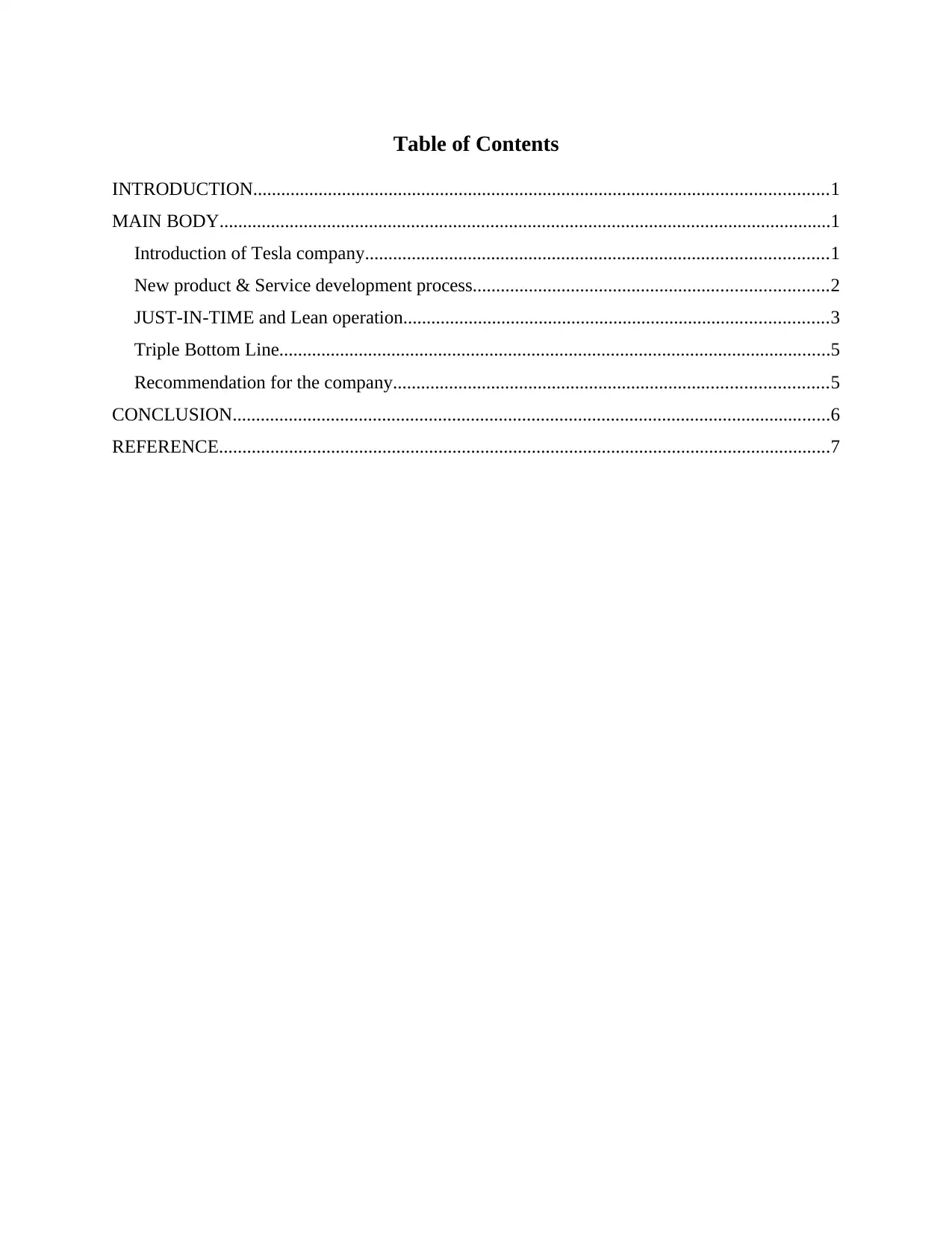
Table of Contents
INTRODUCTION...........................................................................................................................1
MAIN BODY...................................................................................................................................1
Introduction of Tesla company...................................................................................................1
New product & Service development process............................................................................2
JUST-IN-TIME and Lean operation...........................................................................................3
Triple Bottom Line......................................................................................................................5
Recommendation for the company.............................................................................................5
CONCLUSION................................................................................................................................6
REFERENCE...................................................................................................................................7
INTRODUCTION...........................................................................................................................1
MAIN BODY...................................................................................................................................1
Introduction of Tesla company...................................................................................................1
New product & Service development process............................................................................2
JUST-IN-TIME and Lean operation...........................................................................................3
Triple Bottom Line......................................................................................................................5
Recommendation for the company.............................................................................................5
CONCLUSION................................................................................................................................6
REFERENCE...................................................................................................................................7
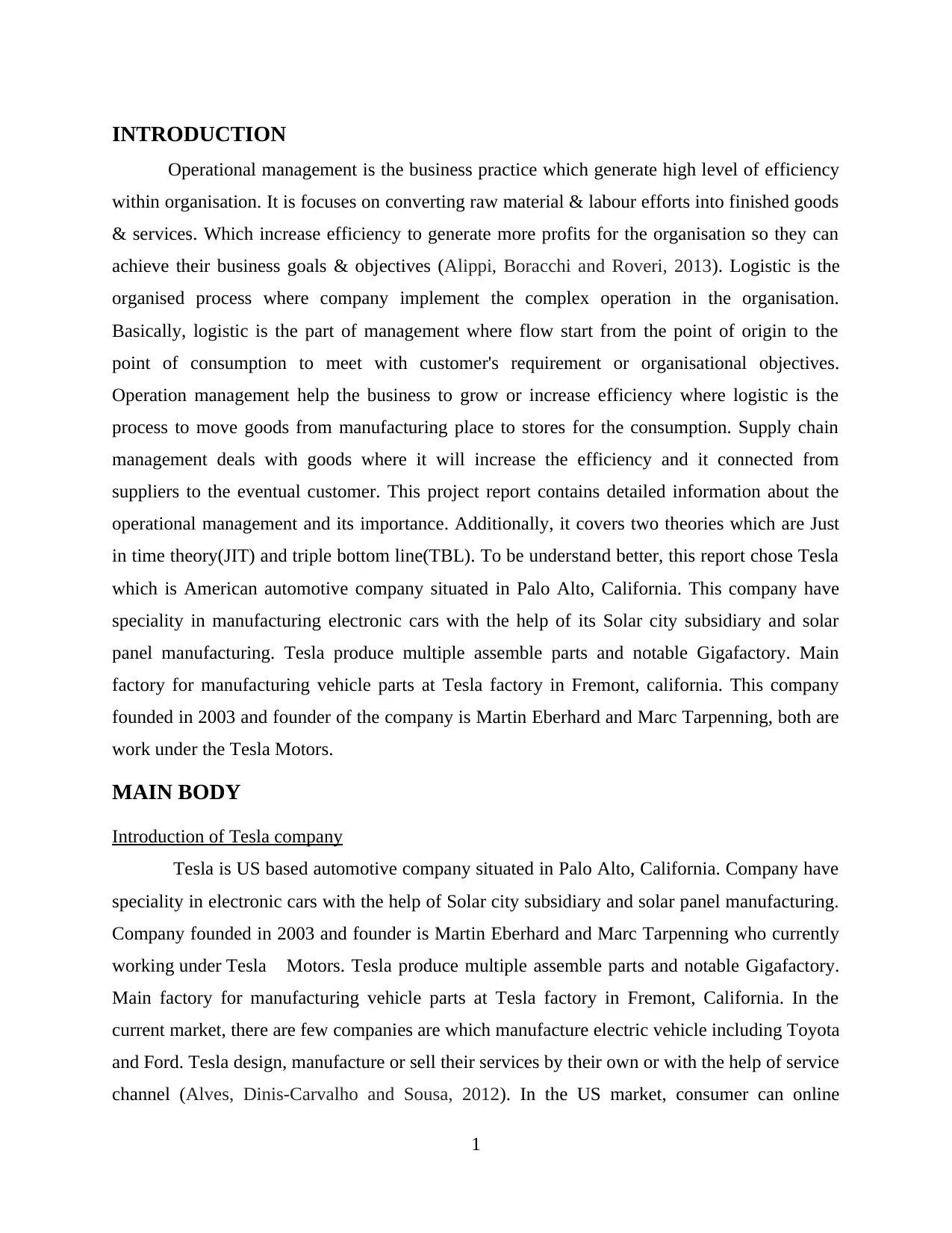
INTRODUCTION
Operational management is the business practice which generate high level of efficiency
within organisation. It is focuses on converting raw material & labour efforts into finished goods
& services. Which increase efficiency to generate more profits for the organisation so they can
achieve their business goals & objectives (Alippi, Boracchi and Roveri, 2013). Logistic is the
organised process where company implement the complex operation in the organisation.
Basically, logistic is the part of management where flow start from the point of origin to the
point of consumption to meet with customer's requirement or organisational objectives.
Operation management help the business to grow or increase efficiency where logistic is the
process to move goods from manufacturing place to stores for the consumption. Supply chain
management deals with goods where it will increase the efficiency and it connected from
suppliers to the eventual customer. This project report contains detailed information about the
operational management and its importance. Additionally, it covers two theories which are Just
in time theory(JIT) and triple bottom line(TBL). To be understand better, this report chose Tesla
which is American automotive company situated in Palo Alto, California. This company have
speciality in manufacturing electronic cars with the help of its Solar city subsidiary and solar
panel manufacturing. Tesla produce multiple assemble parts and notable Gigafactory. Main
factory for manufacturing vehicle parts at Tesla factory in Fremont, california. This company
founded in 2003 and founder of the company is Martin Eberhard and Marc Tarpenning, both are
work under the Tesla Motors.
MAIN BODY
Introduction of Tesla company
Tesla is US based automotive company situated in Palo Alto, California. Company have
speciality in electronic cars with the help of Solar city subsidiary and solar panel manufacturing.
Company founded in 2003 and founder is Martin Eberhard and Marc Tarpenning who currently
working under Tesla Motors. Tesla produce multiple assemble parts and notable Gigafactory.
Main factory for manufacturing vehicle parts at Tesla factory in Fremont, California. In the
current market, there are few companies are which manufacture electric vehicle including Toyota
and Ford. Tesla design, manufacture or sell their services by their own or with the help of service
channel (Alves, Dinis-Carvalho and Sousa, 2012). In the US market, consumer can online
1
Operational management is the business practice which generate high level of efficiency
within organisation. It is focuses on converting raw material & labour efforts into finished goods
& services. Which increase efficiency to generate more profits for the organisation so they can
achieve their business goals & objectives (Alippi, Boracchi and Roveri, 2013). Logistic is the
organised process where company implement the complex operation in the organisation.
Basically, logistic is the part of management where flow start from the point of origin to the
point of consumption to meet with customer's requirement or organisational objectives.
Operation management help the business to grow or increase efficiency where logistic is the
process to move goods from manufacturing place to stores for the consumption. Supply chain
management deals with goods where it will increase the efficiency and it connected from
suppliers to the eventual customer. This project report contains detailed information about the
operational management and its importance. Additionally, it covers two theories which are Just
in time theory(JIT) and triple bottom line(TBL). To be understand better, this report chose Tesla
which is American automotive company situated in Palo Alto, California. This company have
speciality in manufacturing electronic cars with the help of its Solar city subsidiary and solar
panel manufacturing. Tesla produce multiple assemble parts and notable Gigafactory. Main
factory for manufacturing vehicle parts at Tesla factory in Fremont, california. This company
founded in 2003 and founder of the company is Martin Eberhard and Marc Tarpenning, both are
work under the Tesla Motors.
MAIN BODY
Introduction of Tesla company
Tesla is US based automotive company situated in Palo Alto, California. Company have
speciality in electronic cars with the help of Solar city subsidiary and solar panel manufacturing.
Company founded in 2003 and founder is Martin Eberhard and Marc Tarpenning who currently
working under Tesla Motors. Tesla produce multiple assemble parts and notable Gigafactory.
Main factory for manufacturing vehicle parts at Tesla factory in Fremont, California. In the
current market, there are few companies are which manufacture electric vehicle including Toyota
and Ford. Tesla design, manufacture or sell their services by their own or with the help of service
channel (Alves, Dinis-Carvalho and Sousa, 2012). In the US market, consumer can online
1
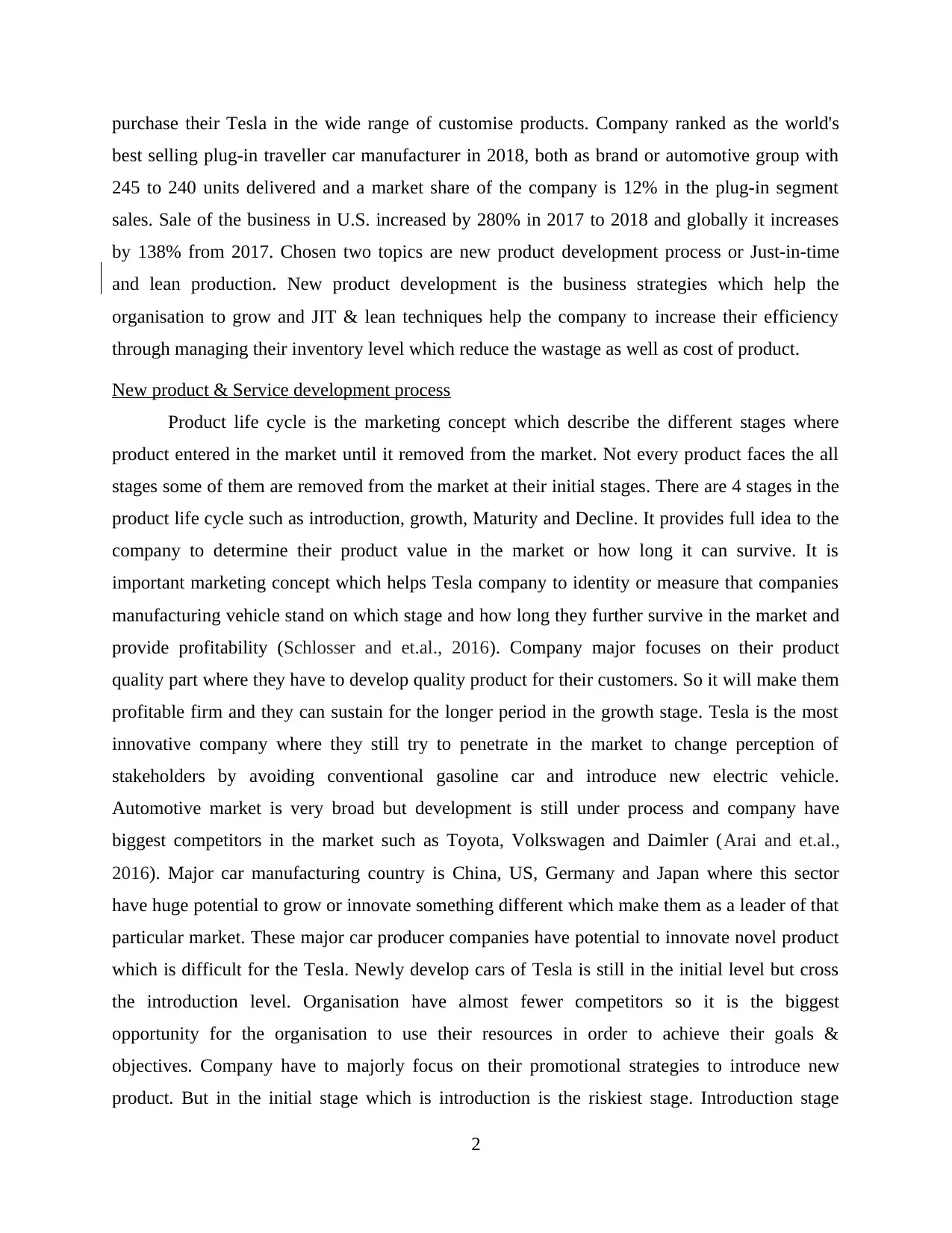
purchase their Tesla in the wide range of customise products. Company ranked as the world's
best selling plug-in traveller car manufacturer in 2018, both as brand or automotive group with
245 to 240 units delivered and a market share of the company is 12% in the plug-in segment
sales. Sale of the business in U.S. increased by 280% in 2017 to 2018 and globally it increases
by 138% from 2017. Chosen two topics are new product development process or Just-in-time
and lean production. New product development is the business strategies which help the
organisation to grow and JIT & lean techniques help the company to increase their efficiency
through managing their inventory level which reduce the wastage as well as cost of product.
New product & Service development process
Product life cycle is the marketing concept which describe the different stages where
product entered in the market until it removed from the market. Not every product faces the all
stages some of them are removed from the market at their initial stages. There are 4 stages in the
product life cycle such as introduction, growth, Maturity and Decline. It provides full idea to the
company to determine their product value in the market or how long it can survive. It is
important marketing concept which helps Tesla company to identity or measure that companies
manufacturing vehicle stand on which stage and how long they further survive in the market and
provide profitability (Schlosser and et.al., 2016). Company major focuses on their product
quality part where they have to develop quality product for their customers. So it will make them
profitable firm and they can sustain for the longer period in the growth stage. Tesla is the most
innovative company where they still try to penetrate in the market to change perception of
stakeholders by avoiding conventional gasoline car and introduce new electric vehicle.
Automotive market is very broad but development is still under process and company have
biggest competitors in the market such as Toyota, Volkswagen and Daimler (Arai and et.al.,
2016). Major car manufacturing country is China, US, Germany and Japan where this sector
have huge potential to grow or innovate something different which make them as a leader of that
particular market. These major car producer companies have potential to innovate novel product
which is difficult for the Tesla. Newly develop cars of Tesla is still in the initial level but cross
the introduction level. Organisation have almost fewer competitors so it is the biggest
opportunity for the organisation to use their resources in order to achieve their goals &
objectives. Company have to majorly focus on their promotional strategies to introduce new
product. But in the initial stage which is introduction is the riskiest stage. Introduction stage
2
best selling plug-in traveller car manufacturer in 2018, both as brand or automotive group with
245 to 240 units delivered and a market share of the company is 12% in the plug-in segment
sales. Sale of the business in U.S. increased by 280% in 2017 to 2018 and globally it increases
by 138% from 2017. Chosen two topics are new product development process or Just-in-time
and lean production. New product development is the business strategies which help the
organisation to grow and JIT & lean techniques help the company to increase their efficiency
through managing their inventory level which reduce the wastage as well as cost of product.
New product & Service development process
Product life cycle is the marketing concept which describe the different stages where
product entered in the market until it removed from the market. Not every product faces the all
stages some of them are removed from the market at their initial stages. There are 4 stages in the
product life cycle such as introduction, growth, Maturity and Decline. It provides full idea to the
company to determine their product value in the market or how long it can survive. It is
important marketing concept which helps Tesla company to identity or measure that companies
manufacturing vehicle stand on which stage and how long they further survive in the market and
provide profitability (Schlosser and et.al., 2016). Company major focuses on their product
quality part where they have to develop quality product for their customers. So it will make them
profitable firm and they can sustain for the longer period in the growth stage. Tesla is the most
innovative company where they still try to penetrate in the market to change perception of
stakeholders by avoiding conventional gasoline car and introduce new electric vehicle.
Automotive market is very broad but development is still under process and company have
biggest competitors in the market such as Toyota, Volkswagen and Daimler (Arai and et.al.,
2016). Major car manufacturing country is China, US, Germany and Japan where this sector
have huge potential to grow or innovate something different which make them as a leader of that
particular market. These major car producer companies have potential to innovate novel product
which is difficult for the Tesla. Newly develop cars of Tesla is still in the initial level but cross
the introduction level. Organisation have almost fewer competitors so it is the biggest
opportunity for the organisation to use their resources in order to achieve their goals &
objectives. Company have to majorly focus on their promotional strategies to introduce new
product. But in the initial stage which is introduction is the riskiest stage. Introduction stage
2
Secure Best Marks with AI Grader
Need help grading? Try our AI Grader for instant feedback on your assignments.
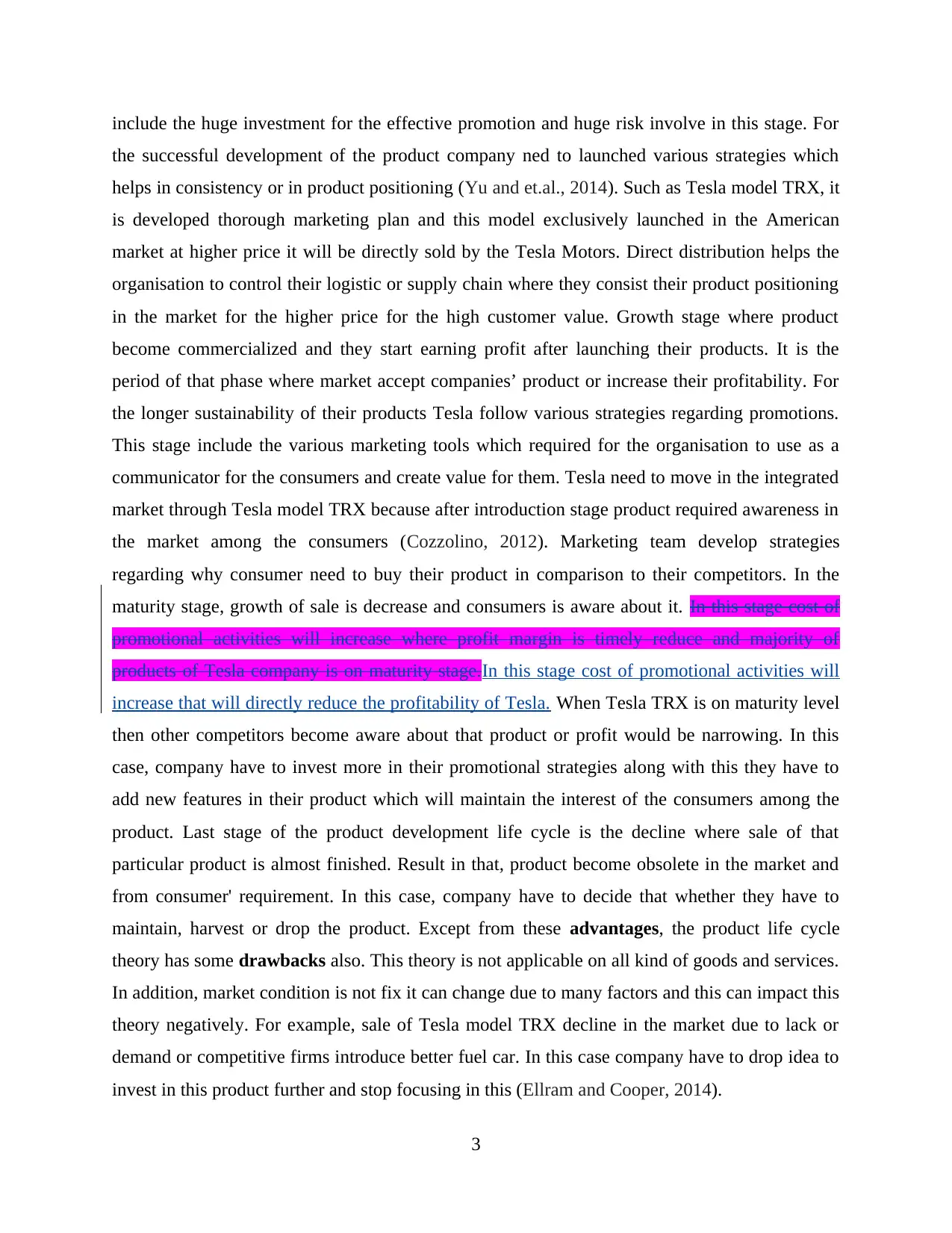
include the huge investment for the effective promotion and huge risk involve in this stage. For
the successful development of the product company ned to launched various strategies which
helps in consistency or in product positioning (Yu and et.al., 2014). Such as Tesla model TRX, it
is developed thorough marketing plan and this model exclusively launched in the American
market at higher price it will be directly sold by the Tesla Motors. Direct distribution helps the
organisation to control their logistic or supply chain where they consist their product positioning
in the market for the higher price for the high customer value. Growth stage where product
become commercialized and they start earning profit after launching their products. It is the
period of that phase where market accept companies’ product or increase their profitability. For
the longer sustainability of their products Tesla follow various strategies regarding promotions.
This stage include the various marketing tools which required for the organisation to use as a
communicator for the consumers and create value for them. Tesla need to move in the integrated
market through Tesla model TRX because after introduction stage product required awareness in
the market among the consumers (Cozzolino, 2012). Marketing team develop strategies
regarding why consumer need to buy their product in comparison to their competitors. In the
maturity stage, growth of sale is decrease and consumers is aware about it. In this stage cost of
promotional activities will increase where profit margin is timely reduce and majority of
products of Tesla company is on maturity stage.In this stage cost of promotional activities will
increase that will directly reduce the profitability of Tesla. When Tesla TRX is on maturity level
then other competitors become aware about that product or profit would be narrowing. In this
case, company have to invest more in their promotional strategies along with this they have to
add new features in their product which will maintain the interest of the consumers among the
product. Last stage of the product development life cycle is the decline where sale of that
particular product is almost finished. Result in that, product become obsolete in the market and
from consumer' requirement. In this case, company have to decide that whether they have to
maintain, harvest or drop the product. Except from these advantages, the product life cycle
theory has some drawbacks also. This theory is not applicable on all kind of goods and services.
In addition, market condition is not fix it can change due to many factors and this can impact this
theory negatively. For example, sale of Tesla model TRX decline in the market due to lack or
demand or competitive firms introduce better fuel car. In this case company have to drop idea to
invest in this product further and stop focusing in this (Ellram and Cooper, 2014).
3
the successful development of the product company ned to launched various strategies which
helps in consistency or in product positioning (Yu and et.al., 2014). Such as Tesla model TRX, it
is developed thorough marketing plan and this model exclusively launched in the American
market at higher price it will be directly sold by the Tesla Motors. Direct distribution helps the
organisation to control their logistic or supply chain where they consist their product positioning
in the market for the higher price for the high customer value. Growth stage where product
become commercialized and they start earning profit after launching their products. It is the
period of that phase where market accept companies’ product or increase their profitability. For
the longer sustainability of their products Tesla follow various strategies regarding promotions.
This stage include the various marketing tools which required for the organisation to use as a
communicator for the consumers and create value for them. Tesla need to move in the integrated
market through Tesla model TRX because after introduction stage product required awareness in
the market among the consumers (Cozzolino, 2012). Marketing team develop strategies
regarding why consumer need to buy their product in comparison to their competitors. In the
maturity stage, growth of sale is decrease and consumers is aware about it. In this stage cost of
promotional activities will increase where profit margin is timely reduce and majority of
products of Tesla company is on maturity stage.In this stage cost of promotional activities will
increase that will directly reduce the profitability of Tesla. When Tesla TRX is on maturity level
then other competitors become aware about that product or profit would be narrowing. In this
case, company have to invest more in their promotional strategies along with this they have to
add new features in their product which will maintain the interest of the consumers among the
product. Last stage of the product development life cycle is the decline where sale of that
particular product is almost finished. Result in that, product become obsolete in the market and
from consumer' requirement. In this case, company have to decide that whether they have to
maintain, harvest or drop the product. Except from these advantages, the product life cycle
theory has some drawbacks also. This theory is not applicable on all kind of goods and services.
In addition, market condition is not fix it can change due to many factors and this can impact this
theory negatively. For example, sale of Tesla model TRX decline in the market due to lack or
demand or competitive firms introduce better fuel car. In this case company have to drop idea to
invest in this product further and stop focusing in this (Ellram and Cooper, 2014).
3
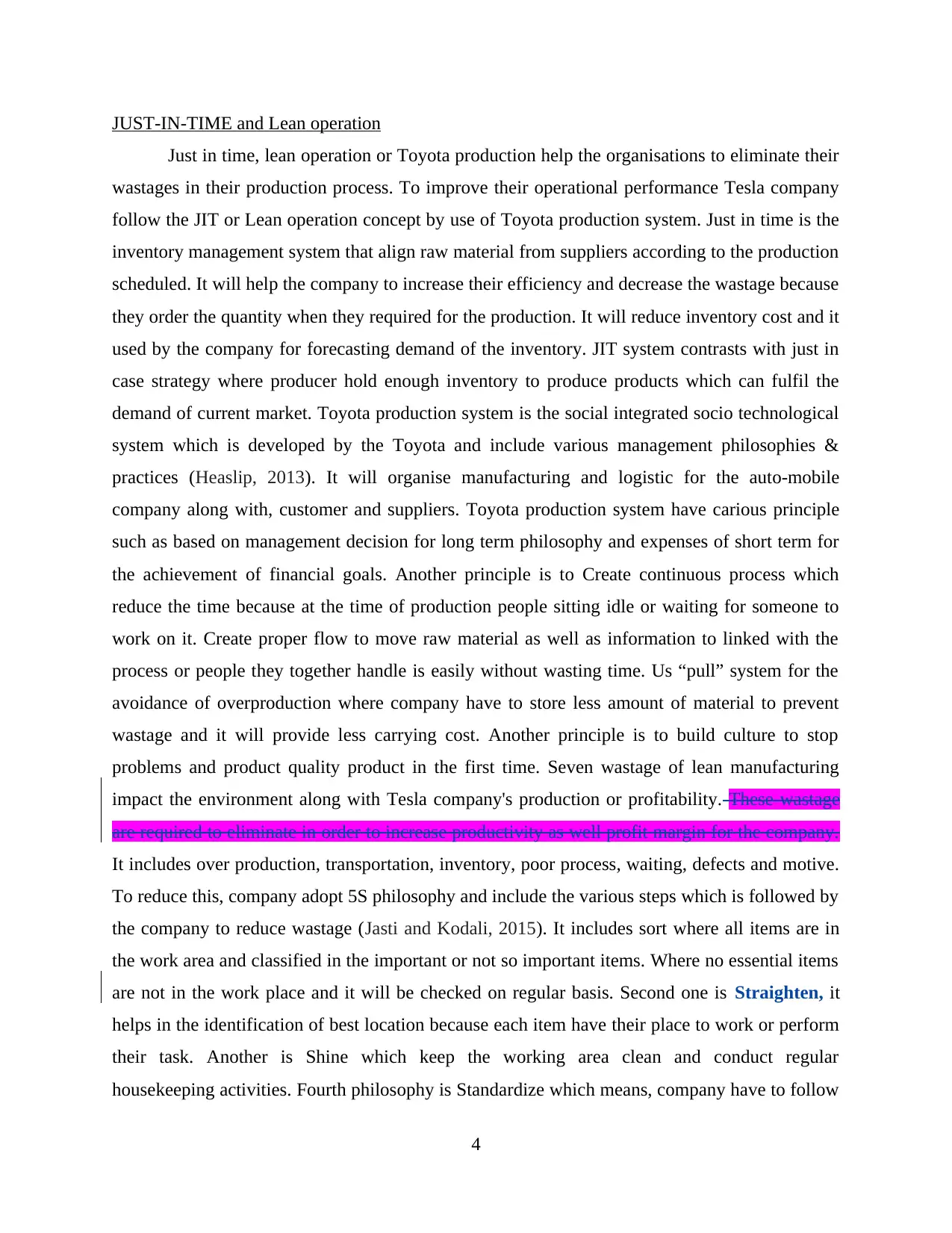
JUST-IN-TIME and Lean operation
Just in time, lean operation or Toyota production help the organisations to eliminate their
wastages in their production process. To improve their operational performance Tesla company
follow the JIT or Lean operation concept by use of Toyota production system. Just in time is the
inventory management system that align raw material from suppliers according to the production
scheduled. It will help the company to increase their efficiency and decrease the wastage because
they order the quantity when they required for the production. It will reduce inventory cost and it
used by the company for forecasting demand of the inventory. JIT system contrasts with just in
case strategy where producer hold enough inventory to produce products which can fulfil the
demand of current market. Toyota production system is the social integrated socio technological
system which is developed by the Toyota and include various management philosophies &
practices (Heaslip, 2013). It will organise manufacturing and logistic for the auto-mobile
company along with, customer and suppliers. Toyota production system have carious principle
such as based on management decision for long term philosophy and expenses of short term for
the achievement of financial goals. Another principle is to Create continuous process which
reduce the time because at the time of production people sitting idle or waiting for someone to
work on it. Create proper flow to move raw material as well as information to linked with the
process or people they together handle is easily without wasting time. Us “pull” system for the
avoidance of overproduction where company have to store less amount of material to prevent
wastage and it will provide less carrying cost. Another principle is to build culture to stop
problems and product quality product in the first time. Seven wastage of lean manufacturing
impact the environment along with Tesla company's production or profitability. These wastage
are required to eliminate in order to increase productivity as well profit margin for the company.
It includes over production, transportation, inventory, poor process, waiting, defects and motive.
To reduce this, company adopt 5S philosophy and include the various steps which is followed by
the company to reduce wastage (Jasti and Kodali, 2015). It includes sort where all items are in
the work area and classified in the important or not so important items. Where no essential items
are not in the work place and it will be checked on regular basis. Second one is Straighten, it
helps in the identification of best location because each item have their place to work or perform
their task. Another is Shine which keep the working area clean and conduct regular
housekeeping activities. Fourth philosophy is Standardize which means, company have to follow
4
Just in time, lean operation or Toyota production help the organisations to eliminate their
wastages in their production process. To improve their operational performance Tesla company
follow the JIT or Lean operation concept by use of Toyota production system. Just in time is the
inventory management system that align raw material from suppliers according to the production
scheduled. It will help the company to increase their efficiency and decrease the wastage because
they order the quantity when they required for the production. It will reduce inventory cost and it
used by the company for forecasting demand of the inventory. JIT system contrasts with just in
case strategy where producer hold enough inventory to produce products which can fulfil the
demand of current market. Toyota production system is the social integrated socio technological
system which is developed by the Toyota and include various management philosophies &
practices (Heaslip, 2013). It will organise manufacturing and logistic for the auto-mobile
company along with, customer and suppliers. Toyota production system have carious principle
such as based on management decision for long term philosophy and expenses of short term for
the achievement of financial goals. Another principle is to Create continuous process which
reduce the time because at the time of production people sitting idle or waiting for someone to
work on it. Create proper flow to move raw material as well as information to linked with the
process or people they together handle is easily without wasting time. Us “pull” system for the
avoidance of overproduction where company have to store less amount of material to prevent
wastage and it will provide less carrying cost. Another principle is to build culture to stop
problems and product quality product in the first time. Seven wastage of lean manufacturing
impact the environment along with Tesla company's production or profitability. These wastage
are required to eliminate in order to increase productivity as well profit margin for the company.
It includes over production, transportation, inventory, poor process, waiting, defects and motive.
To reduce this, company adopt 5S philosophy and include the various steps which is followed by
the company to reduce wastage (Jasti and Kodali, 2015). It includes sort where all items are in
the work area and classified in the important or not so important items. Where no essential items
are not in the work place and it will be checked on regular basis. Second one is Straighten, it
helps in the identification of best location because each item have their place to work or perform
their task. Another is Shine which keep the working area clean and conduct regular
housekeeping activities. Fourth philosophy is Standardize which means, company have to follow
4
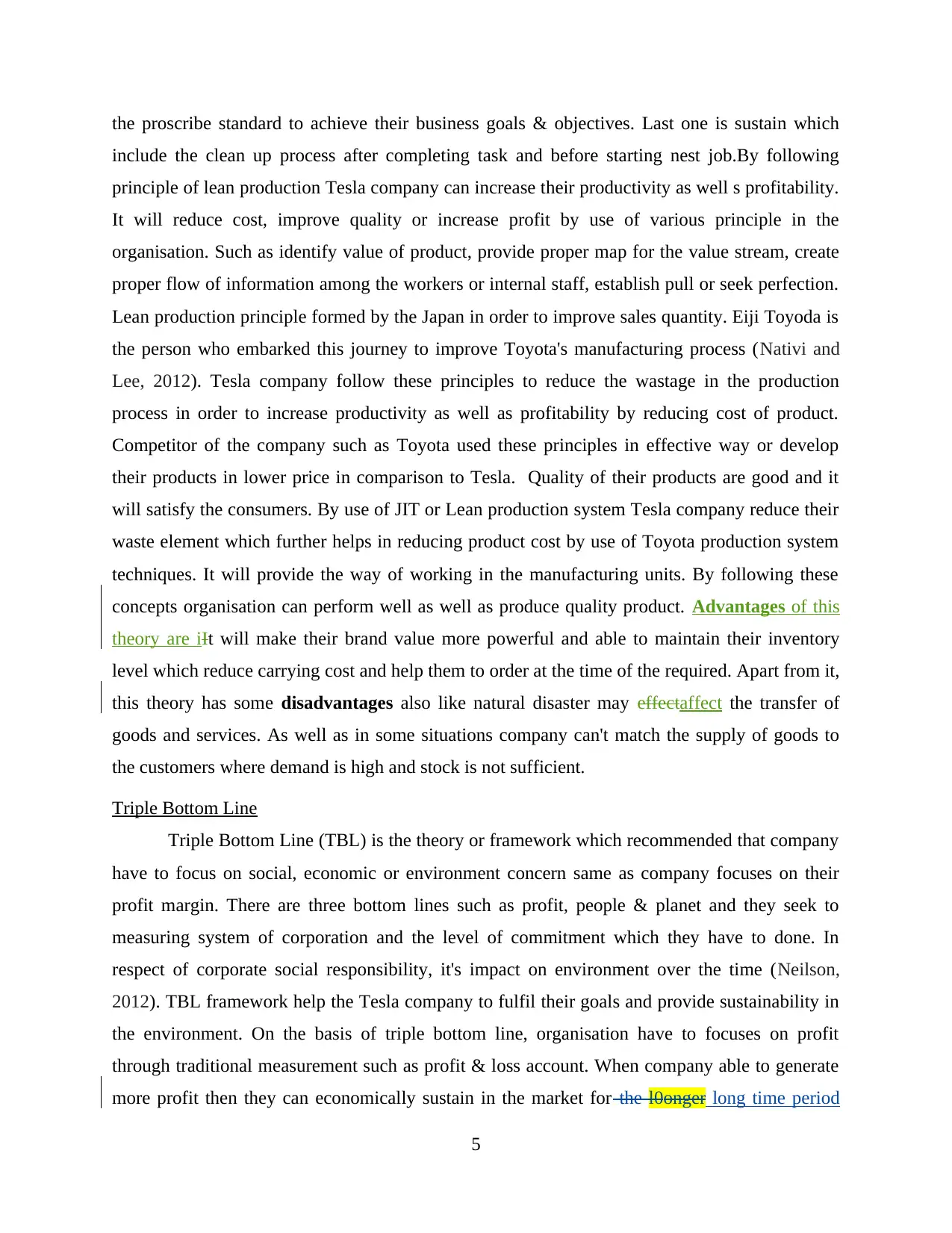
the proscribe standard to achieve their business goals & objectives. Last one is sustain which
include the clean up process after completing task and before starting nest job.By following
principle of lean production Tesla company can increase their productivity as well s profitability.
It will reduce cost, improve quality or increase profit by use of various principle in the
organisation. Such as identify value of product, provide proper map for the value stream, create
proper flow of information among the workers or internal staff, establish pull or seek perfection.
Lean production principle formed by the Japan in order to improve sales quantity. Eiji Toyoda is
the person who embarked this journey to improve Toyota's manufacturing process (Nativi and
Lee, 2012). Tesla company follow these principles to reduce the wastage in the production
process in order to increase productivity as well as profitability by reducing cost of product.
Competitor of the company such as Toyota used these principles in effective way or develop
their products in lower price in comparison to Tesla. Quality of their products are good and it
will satisfy the consumers. By use of JIT or Lean production system Tesla company reduce their
waste element which further helps in reducing product cost by use of Toyota production system
techniques. It will provide the way of working in the manufacturing units. By following these
concepts organisation can perform well as well as produce quality product. Advantages of this
theory are iIt will make their brand value more powerful and able to maintain their inventory
level which reduce carrying cost and help them to order at the time of the required. Apart from it,
this theory has some disadvantages also like natural disaster may effectaffect the transfer of
goods and services. As well as in some situations company can't match the supply of goods to
the customers where demand is high and stock is not sufficient.
Triple Bottom Line
Triple Bottom Line (TBL) is the theory or framework which recommended that company
have to focus on social, economic or environment concern same as company focuses on their
profit margin. There are three bottom lines such as profit, people & planet and they seek to
measuring system of corporation and the level of commitment which they have to done. In
respect of corporate social responsibility, it's impact on environment over the time (Neilson,
2012). TBL framework help the Tesla company to fulfil their goals and provide sustainability in
the environment. On the basis of triple bottom line, organisation have to focuses on profit
through traditional measurement such as profit & loss account. When company able to generate
more profit then they can economically sustain in the market for the l0onger long time period
5
include the clean up process after completing task and before starting nest job.By following
principle of lean production Tesla company can increase their productivity as well s profitability.
It will reduce cost, improve quality or increase profit by use of various principle in the
organisation. Such as identify value of product, provide proper map for the value stream, create
proper flow of information among the workers or internal staff, establish pull or seek perfection.
Lean production principle formed by the Japan in order to improve sales quantity. Eiji Toyoda is
the person who embarked this journey to improve Toyota's manufacturing process (Nativi and
Lee, 2012). Tesla company follow these principles to reduce the wastage in the production
process in order to increase productivity as well as profitability by reducing cost of product.
Competitor of the company such as Toyota used these principles in effective way or develop
their products in lower price in comparison to Tesla. Quality of their products are good and it
will satisfy the consumers. By use of JIT or Lean production system Tesla company reduce their
waste element which further helps in reducing product cost by use of Toyota production system
techniques. It will provide the way of working in the manufacturing units. By following these
concepts organisation can perform well as well as produce quality product. Advantages of this
theory are iIt will make their brand value more powerful and able to maintain their inventory
level which reduce carrying cost and help them to order at the time of the required. Apart from it,
this theory has some disadvantages also like natural disaster may effectaffect the transfer of
goods and services. As well as in some situations company can't match the supply of goods to
the customers where demand is high and stock is not sufficient.
Triple Bottom Line
Triple Bottom Line (TBL) is the theory or framework which recommended that company
have to focus on social, economic or environment concern same as company focuses on their
profit margin. There are three bottom lines such as profit, people & planet and they seek to
measuring system of corporation and the level of commitment which they have to done. In
respect of corporate social responsibility, it's impact on environment over the time (Neilson,
2012). TBL framework help the Tesla company to fulfil their goals and provide sustainability in
the environment. On the basis of triple bottom line, organisation have to focuses on profit
through traditional measurement such as profit & loss account. When company able to generate
more profit then they can economically sustain in the market for the l0onger long time period
5
Paraphrase This Document
Need a fresh take? Get an instant paraphrase of this document with our AI Paraphraser
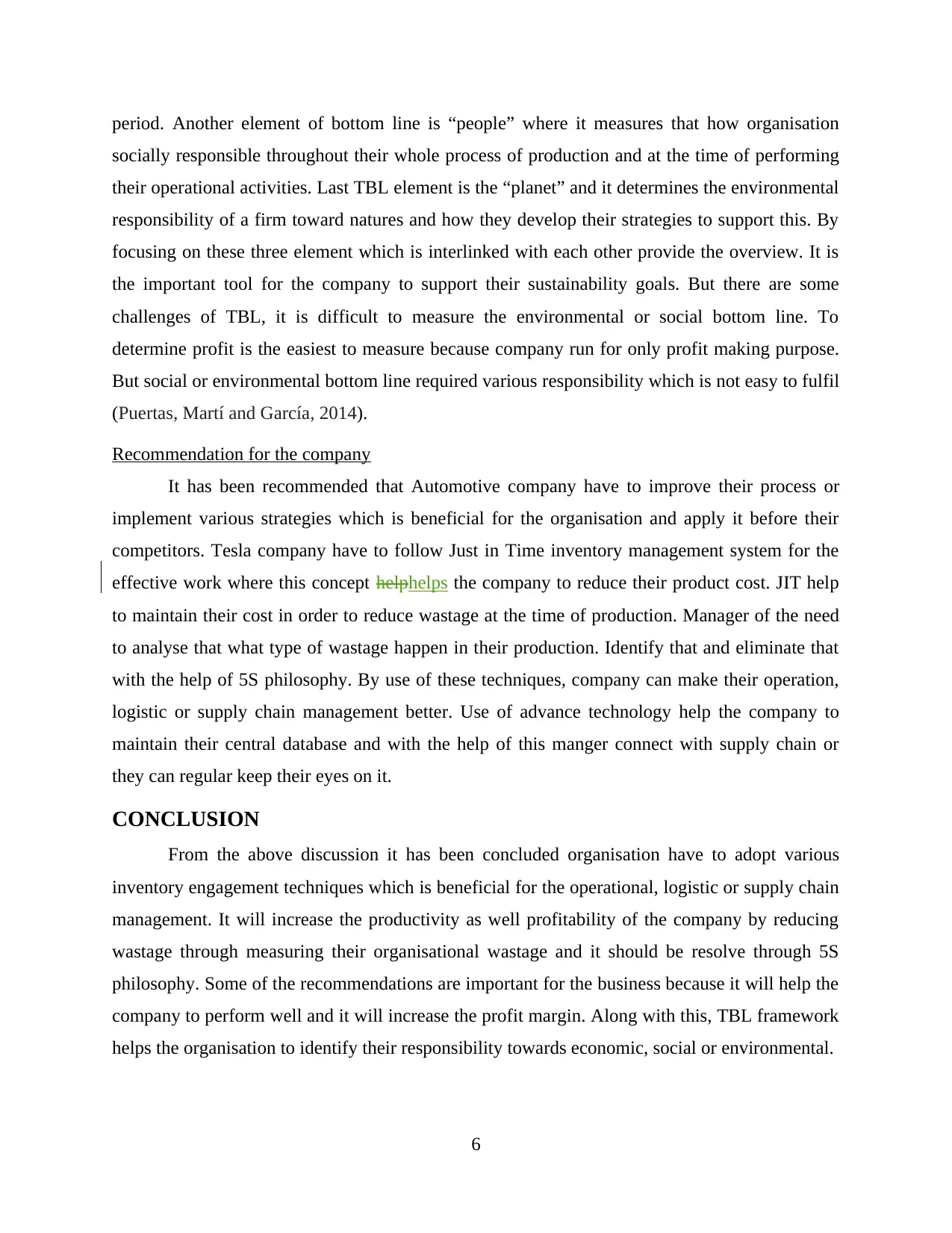
period. Another element of bottom line is “people” where it measures that how organisation
socially responsible throughout their whole process of production and at the time of performing
their operational activities. Last TBL element is the “planet” and it determines the environmental
responsibility of a firm toward natures and how they develop their strategies to support this. By
focusing on these three element which is interlinked with each other provide the overview. It is
the important tool for the company to support their sustainability goals. But there are some
challenges of TBL, it is difficult to measure the environmental or social bottom line. To
determine profit is the easiest to measure because company run for only profit making purpose.
But social or environmental bottom line required various responsibility which is not easy to fulfil
(Puertas, Martí and García, 2014).
Recommendation for the company
It has been recommended that Automotive company have to improve their process or
implement various strategies which is beneficial for the organisation and apply it before their
competitors. Tesla company have to follow Just in Time inventory management system for the
effective work where this concept helphelps the company to reduce their product cost. JIT help
to maintain their cost in order to reduce wastage at the time of production. Manager of the need
to analyse that what type of wastage happen in their production. Identify that and eliminate that
with the help of 5S philosophy. By use of these techniques, company can make their operation,
logistic or supply chain management better. Use of advance technology help the company to
maintain their central database and with the help of this manger connect with supply chain or
they can regular keep their eyes on it.
CONCLUSION
From the above discussion it has been concluded organisation have to adopt various
inventory engagement techniques which is beneficial for the operational, logistic or supply chain
management. It will increase the productivity as well profitability of the company by reducing
wastage through measuring their organisational wastage and it should be resolve through 5S
philosophy. Some of the recommendations are important for the business because it will help the
company to perform well and it will increase the profit margin. Along with this, TBL framework
helps the organisation to identify their responsibility towards economic, social or environmental.
6
socially responsible throughout their whole process of production and at the time of performing
their operational activities. Last TBL element is the “planet” and it determines the environmental
responsibility of a firm toward natures and how they develop their strategies to support this. By
focusing on these three element which is interlinked with each other provide the overview. It is
the important tool for the company to support their sustainability goals. But there are some
challenges of TBL, it is difficult to measure the environmental or social bottom line. To
determine profit is the easiest to measure because company run for only profit making purpose.
But social or environmental bottom line required various responsibility which is not easy to fulfil
(Puertas, Martí and García, 2014).
Recommendation for the company
It has been recommended that Automotive company have to improve their process or
implement various strategies which is beneficial for the organisation and apply it before their
competitors. Tesla company have to follow Just in Time inventory management system for the
effective work where this concept helphelps the company to reduce their product cost. JIT help
to maintain their cost in order to reduce wastage at the time of production. Manager of the need
to analyse that what type of wastage happen in their production. Identify that and eliminate that
with the help of 5S philosophy. By use of these techniques, company can make their operation,
logistic or supply chain management better. Use of advance technology help the company to
maintain their central database and with the help of this manger connect with supply chain or
they can regular keep their eyes on it.
CONCLUSION
From the above discussion it has been concluded organisation have to adopt various
inventory engagement techniques which is beneficial for the operational, logistic or supply chain
management. It will increase the productivity as well profitability of the company by reducing
wastage through measuring their organisational wastage and it should be resolve through 5S
philosophy. Some of the recommendations are important for the business because it will help the
company to perform well and it will increase the profit margin. Along with this, TBL framework
helps the organisation to identify their responsibility towards economic, social or environmental.
6
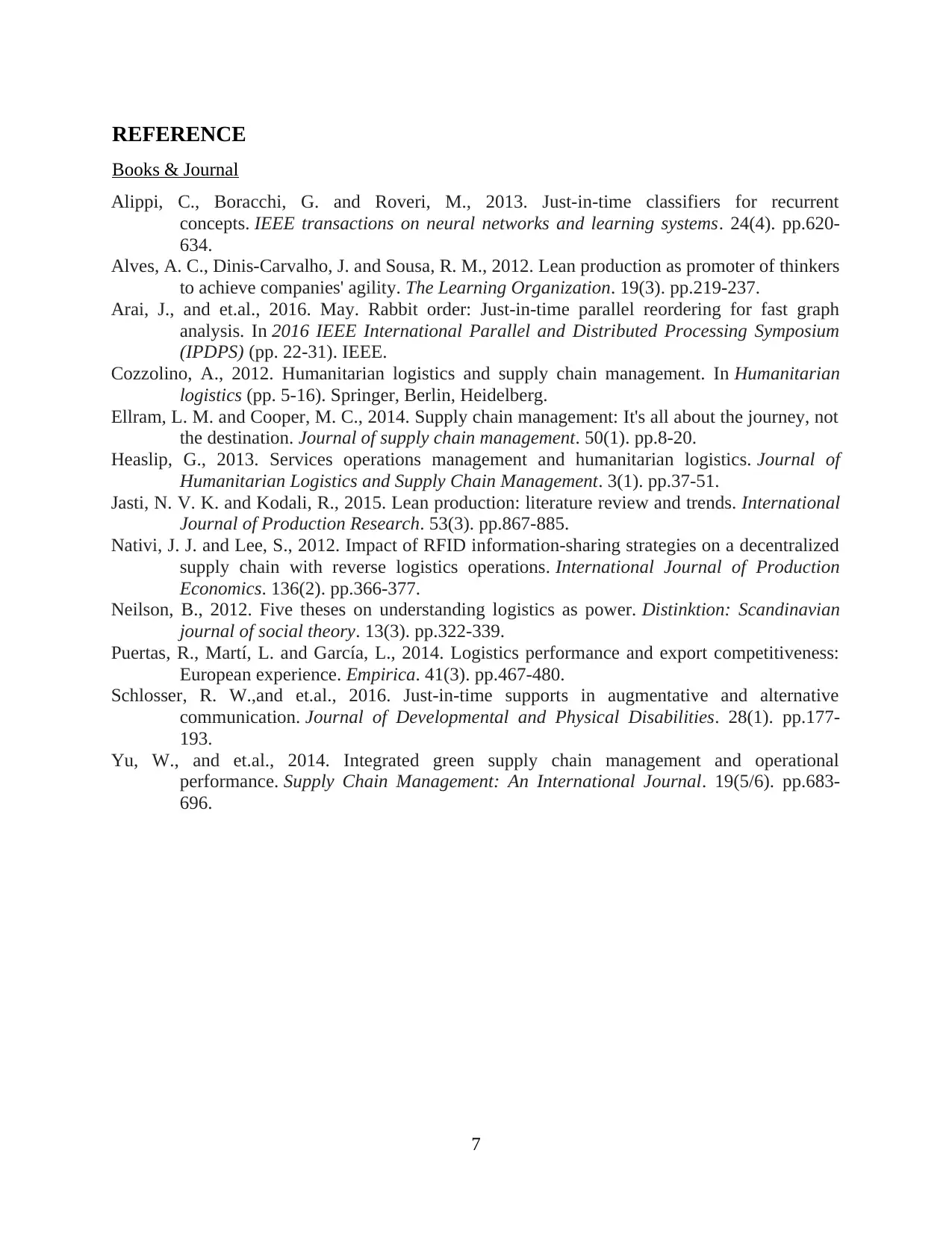
REFERENCE
Books & Journal
Alippi, C., Boracchi, G. and Roveri, M., 2013. Just-in-time classifiers for recurrent
concepts. IEEE transactions on neural networks and learning systems. 24(4). pp.620-
634.
Alves, A. C., Dinis-Carvalho, J. and Sousa, R. M., 2012. Lean production as promoter of thinkers
to achieve companies' agility. The Learning Organization. 19(3). pp.219-237.
Arai, J., and et.al., 2016. May. Rabbit order: Just-in-time parallel reordering for fast graph
analysis. In 2016 IEEE International Parallel and Distributed Processing Symposium
(IPDPS) (pp. 22-31). IEEE.
Cozzolino, A., 2012. Humanitarian logistics and supply chain management. In Humanitarian
logistics (pp. 5-16). Springer, Berlin, Heidelberg.
Ellram, L. M. and Cooper, M. C., 2014. Supply chain management: It's all about the journey, not
the destination. Journal of supply chain management. 50(1). pp.8-20.
Heaslip, G., 2013. Services operations management and humanitarian logistics. Journal of
Humanitarian Logistics and Supply Chain Management. 3(1). pp.37-51.
Jasti, N. V. K. and Kodali, R., 2015. Lean production: literature review and trends. International
Journal of Production Research. 53(3). pp.867-885.
Nativi, J. J. and Lee, S., 2012. Impact of RFID information-sharing strategies on a decentralized
supply chain with reverse logistics operations. International Journal of Production
Economics. 136(2). pp.366-377.
Neilson, B., 2012. Five theses on understanding logistics as power. Distinktion: Scandinavian
journal of social theory. 13(3). pp.322-339.
Puertas, R., Martí, L. and García, L., 2014. Logistics performance and export competitiveness:
European experience. Empirica. 41(3). pp.467-480.
Schlosser, R. W.,and et.al., 2016. Just-in-time supports in augmentative and alternative
communication. Journal of Developmental and Physical Disabilities. 28(1). pp.177-
193.
Yu, W., and et.al., 2014. Integrated green supply chain management and operational
performance. Supply Chain Management: An International Journal. 19(5/6). pp.683-
696.
7
Books & Journal
Alippi, C., Boracchi, G. and Roveri, M., 2013. Just-in-time classifiers for recurrent
concepts. IEEE transactions on neural networks and learning systems. 24(4). pp.620-
634.
Alves, A. C., Dinis-Carvalho, J. and Sousa, R. M., 2012. Lean production as promoter of thinkers
to achieve companies' agility. The Learning Organization. 19(3). pp.219-237.
Arai, J., and et.al., 2016. May. Rabbit order: Just-in-time parallel reordering for fast graph
analysis. In 2016 IEEE International Parallel and Distributed Processing Symposium
(IPDPS) (pp. 22-31). IEEE.
Cozzolino, A., 2012. Humanitarian logistics and supply chain management. In Humanitarian
logistics (pp. 5-16). Springer, Berlin, Heidelberg.
Ellram, L. M. and Cooper, M. C., 2014. Supply chain management: It's all about the journey, not
the destination. Journal of supply chain management. 50(1). pp.8-20.
Heaslip, G., 2013. Services operations management and humanitarian logistics. Journal of
Humanitarian Logistics and Supply Chain Management. 3(1). pp.37-51.
Jasti, N. V. K. and Kodali, R., 2015. Lean production: literature review and trends. International
Journal of Production Research. 53(3). pp.867-885.
Nativi, J. J. and Lee, S., 2012. Impact of RFID information-sharing strategies on a decentralized
supply chain with reverse logistics operations. International Journal of Production
Economics. 136(2). pp.366-377.
Neilson, B., 2012. Five theses on understanding logistics as power. Distinktion: Scandinavian
journal of social theory. 13(3). pp.322-339.
Puertas, R., Martí, L. and García, L., 2014. Logistics performance and export competitiveness:
European experience. Empirica. 41(3). pp.467-480.
Schlosser, R. W.,and et.al., 2016. Just-in-time supports in augmentative and alternative
communication. Journal of Developmental and Physical Disabilities. 28(1). pp.177-
193.
Yu, W., and et.al., 2014. Integrated green supply chain management and operational
performance. Supply Chain Management: An International Journal. 19(5/6). pp.683-
696.
7
1 out of 9
Related Documents
Your All-in-One AI-Powered Toolkit for Academic Success.
+13062052269
info@desklib.com
Available 24*7 on WhatsApp / Email
![[object Object]](/_next/static/media/star-bottom.7253800d.svg)
Unlock your academic potential
© 2024 | Zucol Services PVT LTD | All rights reserved.





